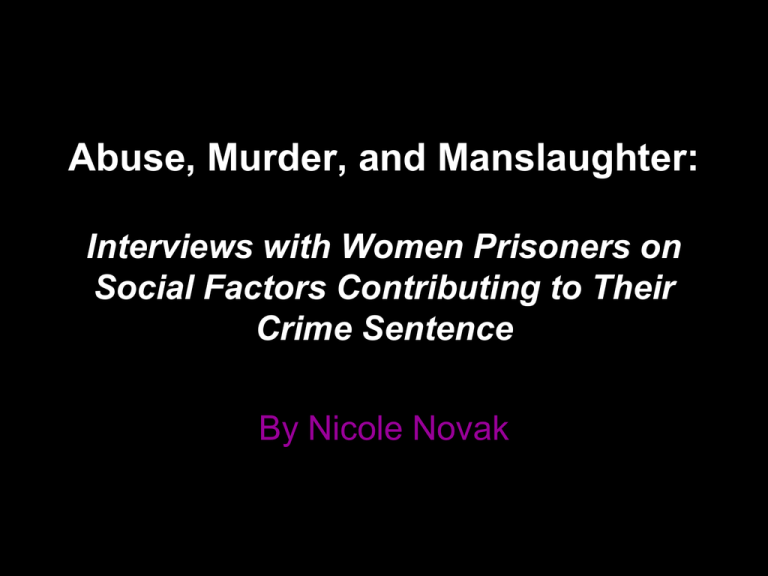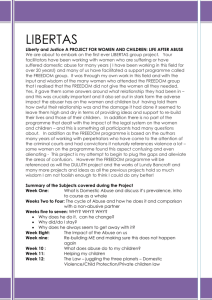Power Point - Saint Mary's College
advertisement

Abuse, Murder, and Manslaughter: Interviews with Women Prisoners on Social Factors Contributing to Their Crime Sentence By Nicole Novak Introduction • Women’s Prisons vs. Men’s Prisons – Indiana Women’s Prison • First Offense • Stereotype • Juvenile Offenses Purpose and Thesis •Limited qualitative research on women in prison •Social factors •Demographic characteristics linked to social factors Literature Review • Increase of women in prison – Richards and Tittle (1981) – Banks (2003) • Indiana Women’s Prison – Banks (2003) – Indiana Department of Correction (2007) Literature Review • Demographic characteristics – Education and Occupation • Fletcher, Shaver, and Moon (1993) • Daly (1994) – Substance abuse • Daly (1994) • Fletcher, Shaver, and Moon (1993) • Flowers (1995) – Physical and sexual abuse • Owen (1998) • Fletcher, Shaver, and Moon (1993) • Daly (1994) – Criminal activity • Daly (1994) • Flowers (1995) Theory • Structural Strain Theory – Goals and means – Anomie – Five types of adaptation • Steffensmeier and Allan – Gendered theories for committing crimes Theory Table 1: Merton’s Types of Adaptation Modes of Adaptation I. Conformity Cultural Goals + Institutionalized Means + II. Innovation + - III. Ritualism - + IV. Retreatism - - V. Rebellion +and- +and- Methodology • Participants – Four women – Ages 19+ – Gatekeeper’s list of ten women • Random Sample – Three participants were white – One participant was African American – Education – Offense – Pseudo-name given • Procedures and Materials – Interview schedule • Questions included: – Personal and family history – Tape-recorded – Length of interviews – Transcribed Methodology • Strengths – – – – Rich data Rapport Response rate Accessibility and contribution • Limitations – Difficult to relate to women in prison – List of women provided to me Findings • Family Background – Biological parents – Foster care – Prominence of parents in formative years Findings • Religion – Sarah • Was Presbyterian, now Mennonite – Mary • No preference – Connie • Was the Eastern Star Masonic Church, now no preference – Jenny • Was Islamic, now Christian • Referring to the Nation of Islam: – “I don’t care what anybody says, it’s a cult. …So that kind of led to the isolation that allowed the drinking, my son to pass, and the process of that, they [the Nation of Islam] didn’t allow any of my friends to interject.” Abuse Table 2: Abuse Interviewees Endured From Their Parents During Their Childhood Interviewee’s Name Type of Abuse (Mental, Physical, Sexual) Age at Which Abuse Took Abuser Sarah Physical, Mental 5-16 years old Father Mary Sexual 7-11 years old Father Jenny Physical, Mental Physical = 11-13 years old Mental = all her life Mother Connie Physical, Sexual 10-12 years old Father Place Abuse • Sarah – “I don’t remember anything but because of my psychological tests, there is – it shows that I have been, so I don’t really know for sure because I don’t have a memory.” • Mary – Psychiatrists – Family history Drug and Alcohol Usage Table 3: Interviewee’s Drug and Alcohol Usage Prior to Imprisonment Name of Interviewee Name of Drug or Alcohol Year(s) of Usage Heavy, Moderate, or Social Usage Sarah Marijuana Alcohol 1970-1974 1973-1992 Social and Moderate Social Mary Alcohol 1982-1994 Social Jenny Alcohol Prescription Medication (Prozac, Ativan, and Deseril) Marijuana 1990-1993 1992-1996 Heavy Heavy 1990-1993 Social Alcohol 1994-1996 Social Connie Drug and Alcohol Usage • Jenny – “I came into the county jail with my prescription medication in my purse.” Previous Offenses • • • • First time imprisoned Juvenile crime Parole or probation Sarah – Childhood history – Abuse Discussion • Attributed to deviant acts – Family (biological) background – Abuse – Varied drug and alcohol abuse • Abuse – Implementation of programs • Education – Gatekeeper • Drug and alcohol usage Further Research • More information on a population that is understudied – Identifying social factors that contribute to women’s criminal behavior





